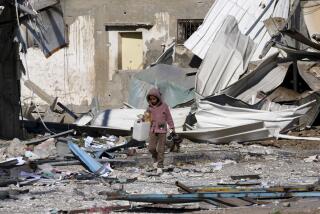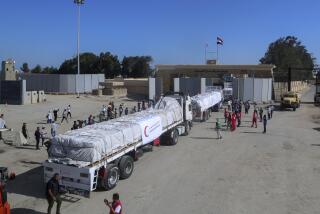Collapse of a World Safety Net
- Share via
MINNEAPOLIS — The words we use to describe crises also signal our response to them. Thus, the global economic turmoil of the past two years is called a “financial crisis,” and our collective response has focused on exchange-rate stability and bank bailouts. Less emphasis has been placed on the victims of these shocks, especially the poor. But they bear the brunt of the adjustment programs that accompany internationally imposed austerity measures.
What is being done to help the global poor cope with the latest round of market chaos? Very little. The advanced industrial democracies now allocate less than 0.25% of their gross national products to foreign assistance, the lowest amount in postwar history. That figure has fallen by more than 50% since 1991. It is hard to think of any other program, domestic or international, that has suffered such cuts. Victimized by the end of the Cold War, on the one hand, and intense fiscal pressures in Europe and North America, on the other, aid has been an easy target for the chopping block. But these reductions, which have occurred without public debate, have had real human costs.
Within developing countries, some 3 billion people live in poverty. Millions are literally without food, clothing, shelter and education. More than 8 million children die each year because of the polluted water they drink and air they breathe. To those in absolute poverty in the developing countries, daily life means another day of suffering.
Unlike the poor in Europe or the United States, these people do not have the luxury of access to state-provided social-safety nets. Their governments are broke, sometimes due to mismanagement and corruption, but also because of forces beyond domestic control: falling commodity prices, declines in global economic growth, financial turmoil. To be sure, aid is no substitute for good governance at home and economic expansion abroad, but it can provide the poor with a bridge as they await those larger changes.
The real tragedy is that aid spending is being reduced to trivial amounts just as knowledge about how to eliminate poverty has reached new heights. Far from being a waste of money, development assistance can be successfully allocated to responsible governments and nongovernmental organizations that make anti-poverty programs a priority. Aid works when it’s effectively targeted.
If we are to craft a humane response to globalization’s meltdown, aid budgets must be increased. Without increases, it is hard to imagine what sort of world the Western allies expect to build. Of all our foreign-policy instruments, aid is the only one that targets the most vulnerable. These are the people we have a vital interest in assisting if we are to create a peaceful world of vibrant democracies and free markets.
Many consider foreign assistance a waste of taxpayer money. That’s ironic, since the most successful foreign-policy initiative in postwar history was the Marshall Plan. At a cost of less than 1% of U.S. gross national product, between 1948 and 1951, Marshall Plan funds provided the catalyst not only for Europe’s postwar economic miracle, but for its subsequent political success as well. Has any other U.S. foreign-policy investment provided anything approaching similar returns?
To be sure, aid has had its failures; one need only remember Mobutu Sese Seko’s pillage of Zaire. But for every Mobutu there have been other recipients of U.S. aid, including South Korea and Taiwan, that flourished, becoming full partners in the global economy. In the process, these countries lifted millions of people out of absolute poverty.
More recently, in the post-communist economies in transition, aid has been of tremendous consequence in Poland, the Czech Republic and Hungary, now all preparing to enter the North Atlantic Treaty Organization. Less well known are the relative success stories in Botswana and Uganda, where economic growth has made these countries models for Africa.
Foreign aid was once a growth industry, tripling from some $20 billion in 1970 to a peak of almost $70 billion in 1991. Since then, however, it has tumbled to insignificant proportions, largely due to decreased spending by the United States
It is sometimes asserted that the decline in aid spending should not concern us, since private-sector financial flows have effectively replaced foreign assistance as the major transfer mechanism between industrial and developing countries. But private-sector flows are highly volatile. They played a significant role during the 1960s and ‘70s, only to fade with the debt crisis of the 1980s. Private actors returned in the 1990s, making the “emerging markets” of Asia, Latin America and Eastern Europe the hottest investment vehicles. Then the global financial crisis that began in 1997 again led to a sharp withdrawal, and today few developing countries are deemed credit-worthy by investors on Wall Street or in the City of London.
More important, these private-sector funds don’t go to schools, hospitals or social-safety nets; they do nothing for the poor in the short run. That’s a job for aid. Further, it’s a job that can be done both efficiently and effectively. Sadly, the aid community has kept that a well-guarded secret. As a result, its resources have been decimated.
Moral arguments for reviving aid won’t carry weight if we fail to show that foreign assistance will be used effectively by organizations that make fighting poverty their priority. But the polling data reveal that few people believe aid can be used effectively. Indeed, most Americans believe the aid programs are plagued by waste and inefficiency. The great majority believes that more than 20% of spending is waste that could be cut painlessly. Most Americans also believe aid is one of the largest items in the federal budget when, in fact, it is trivial: barely $7 billion or .08% of GNP.
Clearly, perceptions about aid must be changed before there can be any significant shift in public support. A major step in the right direction has been taken by the World Bank in a recent report, “Assessing Aid.” It provides compelling evidence that nations’ can target aid and make it more effective in supporting the goal of poverty reduction.
Specifically, the World Bank has found the following to be true about effectiveness:
* First, foreign aid succeeds in helping the poor when it complements domestically sound economic policies. That is, it can help promote growth and the expansion of individual opportunities in those countries that pursue macroeconomic stabilization and structural adjustment measures. It should be emphasized that the effect of such assistance “is large . . . 1% of GDP in assistance translates into a 1% decline in poverty and a similar decline in infant mortality,” according to the World Bank report.
* Second, in such reform-oriented settings, aid and private investment are mutually supportive. Contrary to common belief, there is no evidence that aid “crowds out” the private sector.
* Third, aid in the form of technical assistance can increase both the capacity and capability of state actors. By providing advice about how to make more efficient use of available inputs, it can expand the range of outputs. So higher quality public services end up reaching more citizens, including the poor.
What these points suggest is aid must be better targeted. It should reach not only countries committed to economic reform, but more specifically governments committed to fighting poverty and expanding education and work opportunities for the least advantaged. It should focus on those projects and organizations--including churches and charities--that best promote the fortunes of the most vulnerable.
Too much aid fails to reach those in greatest need. Think of the U.S. foreign-assistance program, which continues to reward Israel and Egypt over all other recipients, and much of this is for military support. A major shift in spending is required, toward high poverty countries pursuing economic reform programs. According to the World Bank, if all donor nations made such “poverty efficient” allocations of their foreign aid, the result would be startling: It would lift some 80 million people each year out of poverty. If aid spending were increased by $10 billion and effectively targeted, an additional 25 million could be uplifted.
To be sure, we cannot limit our justifications for aid to its effectiveness. Clearly, citizens in donor countries must believe they have some moral or material stake in the success of the poor if programs are to win voter support. But the data above should help us to realize that foreign aid is effective when it’s well targeted, and that there is no reason why it couldn’t be better targeted still.
Bringing an end to absolute poverty in the early 21st century is both noble and achievable. Our generation must show the way. If we do not, it is all too possible that the poor in distant lands will be forgotten, or simply held responsible for their own bad luck. Indifference to suffering is hardly unprecedented in human history, and the rapid decrease in aid shows the fragility of our bonds with those who live--and die--beyond our borders.
Increases in development assistance would require an immense dose of moral leadership. That burden is the responsibility of the United States, and sadly it now appears that the great task of global poverty reduction must await the next administration. In the interim, millions of people will suffer. We can certainly pray that their children will meet a happier future, but demanding political action and greater financial resources would be a better use of our time.*
More to Read
Sign up for Essential California
The most important California stories and recommendations in your inbox every morning.
You may occasionally receive promotional content from the Los Angeles Times.










